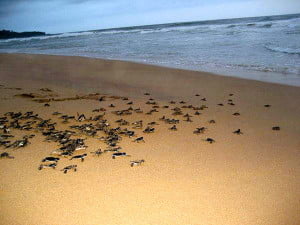LEARN TO DIVE: Essential Steps for Beginner Scuba Divers Are you ready to embark on…

Eco Travel guide: Being a sea turtle volunteer
4.
Eco Travel guide: Being a sea turtle volunteer
Maybe, this is the first time you decide to become a sea turtle volunteer. Or, perhaps you are a seasoned volunteer with multiple turtle trips under your belt. Or, maybe you are just a bit curious about being a sea turtle volunteer. Regardless, here are a few things that you might want to consider before your marine adventure.
Choosing the right turtle project
At this initial stage, researching and choosing the right turtle project can be somewhat daunting with so many online options. Probably you prefer the flexibility to travel and explore places while you volunteer. Or maybe you prefer to dedicate all your time to volunteering. It’s best to think this through so you can make the most out of your time while volunteering at the right project for you.
Also, most conservation projects and organisations are genuinely interested in the conservation of sea turtles while empowering local communities. However, there will be a few which are more interested in selling their volunteering programs as a profit-driven product with disregard to the local wildlife and community. Always choose credible conservation projects and programs which take the safety of turtles and their volunteers seriously. If in doubt, conduct quick online research or check testimonials and reviews from past volunteers.

Sea turtles eat a variety of plants and marine animals, including algae, seagrass, jellyfish, and other molluscs. At Perhentian Islands, green sea turtles can be observed foraging among seagrass beds.
Being aware of nesting and hatching season
Being aware of the nesting and hatching season of sea turtles can increase your chances of seeing them in the wild. Different sea turtle species can have varying nesting and hatching seasons. This depends on different factors such as project location, turtle species, etc. While some nesting and hatching patterns can overlap, some do not.
The project you chose for your turtle volunteering should be able to provide you with this information. For example, at The Perhentian Turtle Project, volunteers have a higher chance of observing foraging turtles during April – September, nesting turtles during May-August, and the arrival of hatchlings from June – September.

A volunteer observing the behaviour of a sea turtle at the Perhentian Islands, Malaysia. One of the best practice to approach a turtle is from behind.
Responsible volunteering with sea turtles
When you observe sea turtles in the sea, it is best to minimise any stress or disturbances by keeping your distance; unless you have a valid reason, e.g, for research purposes, turtle caught or tangled in nets or plastics. In such mitigating cases, always make sure you are comfortable with undertaking the task in hand. And you should know what you are doing to minimise potential risks to you and the animal. If not, the best practice is to inform experienced staff members or contact local turtle conservation organisation or agencies.
When you spot a sea turtle looking for a nest at the beach, always refrain from using bright lights, making sudden movements or approaching the turtle. This can deter nesting turtles from laying eggs and it will more likely return to the sea. Here, it is always a good idea to spend some time observing the nesting turtle and its behaviour from a distance. Normally, the project staff will communicate with you about when and how to approach the nesting turtle.
 Once hatchlings are born and crawl to the surface, you will probably get opportunities to collect and release them. It is always a good practice to handle the turtle hatchlings gently and cautiously since they are delicate. Also, responsible turtle projects release sea turtle hatchlings during the evening or at night, and from different parts of the beach to avoid potential predators. Do ask questions if you aren’t sure about releasing hatchlings, or if you want to learn more about the release method.
Once hatchlings are born and crawl to the surface, you will probably get opportunities to collect and release them. It is always a good practice to handle the turtle hatchlings gently and cautiously since they are delicate. Also, responsible turtle projects release sea turtle hatchlings during the evening or at night, and from different parts of the beach to avoid potential predators. Do ask questions if you aren’t sure about releasing hatchlings, or if you want to learn more about the release method.
Respecting local customs and traditions
The most sensible thing a responsible turtle volunteer can do is to understand and respect local customs and traditions. Be aware that many nesting sites are in areas where local communities are in development or transition. For instance, there may have been a longstanding tradition that turtle eggs are eaten or sold as a local delicacy. These habits may be changing, ideally through the community actions of the local turtle project. So, for the best experience, it is best to follow the guidance of the project team who will know how the background of the local community and its current practices.
Remember that, even after your volunteering experience, you can take many actions to help turtles and the oceans in general. By reducing your use of plastics and making sustainable seafood choices.
ARE YOU LOOKING FOR A JOB IN CONSERVATION?




